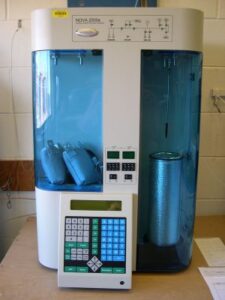
Surface Analysis
Contacts
General Contact
Staff
Location
Campus Address
Institute of Materials Science
Science 1
Storrs Campus
Mailing Address
25 King Hill Road, Unit 3136
Storrs, CT 06269-3136
Instrumentation

Rame Hart Model 100 Goniometer
- Used to determine the static contact angle of a liquid droplet on a solid surface (with 0° being defined as absolute wetting and 180° as completely non-wetting).
- The optical analysis of drops that hang from a dosing needle or are placed on a solid surface facilitates the determination of different surface and interfacial parameters. The contact angle that a liquid drop establishes on a solid surface characterizes the solid’s wetting behavior with said liquid.
- Having measured the contact angles of multiple test liquids the surface energy of the solid can be determined and the latter can be used to calculate the work of adhesion for different liquids.
- The reliable and experimentally robust measurement of the contact angle aids on the development of surface coatings, composite materials, paints and varnishes or cleaning agents.
- In short: the measurement of contact angle helps in all situations where solids and liquids meet, and advantage is to be gained by the control of wetting and adhesion properties

DataPhysics Contact Angle

Material Surface/BET Analyzer
- The NOVA e-Series of surface area analyzers offers a full line of rapid, high throughput B.E.T. surface area and pore size analyzers.
- It uses a nitrogen absorption/desorption process to characterize powders and pellets.
- Analyzes up to 200 data points (100 adsorption points and 100 desorption points).
- Two samples are dried and analyzed simultaneously- at different temperatures if required